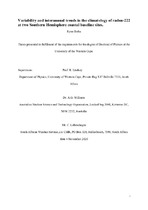| dc.description.abstract | This thesis characterises and discusses two continuous coastal Southern Hemispheric (SH) atmospheric radon (222Rn) signals. Large-scale atmospheric circulation patterns are important components of the climate system implicated in driving catastrophic events such as extreme droughts and mega-wildfires and radon measurements at coastal sites provide valuable information on interactions of terrestrial and oceanic air masses on regional to hemispheric scales. The main collaborating SH atmospheric observatories in this study are located at Cape Grim (CGO, Tasmania, 1992-2017) and Cape Point (CPO, South Africa, 1999-2017). The radon signal from a high-altitude remote island oceanic site in the Northern Hemisphere Mauna Loa Observatory (MLO, Hawaii, 2004-2015) is also incorporated for comparison purposes. The CGO radon signal is the longest and most sensitive in current existence. A variety of statistical, spectral, trend, back-trajectory and trajectory density methods are utilized in this study to illuminate features of the datasets on multiple scales. Strongly skewed radon distributions occur, with a large number of events falling into a compact range of low values (corresponding to marine air-masses) and a smaller number of events spread over a wide range of high-radon values (continental air-masses). Making use of Fast Fourier Transform power spectral analysis, prominent periodicities are identified on diurnal and annual scales. Inter-annual variations in seasonal and diurnal radon and meteorological characteristics, indicating changes in the continental/oceanic atmospheric mixing state, are evident especially during the period from 2012 to 2017, perhaps associated with the strong El-Niño southern oscillation centred on 2015. A slow but systematic decline in CGO and CPO radon levels is evident over the dataset, associated with fewer continental and more marine air-masses impacting the coastal stations. The long-term trends observed in the atmospheric radon signal may indicate changes in SH circulation patterns over time, perhaps associated with climate change effects. | en_US |

